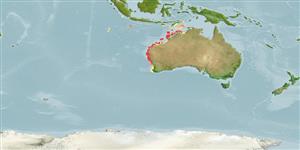Teleostei (teleosts) >
Blenniiformes (Blennies) >
Blenniidae (Combtooth blennies) > Salariinae
Etymology: Ecsenius: Greek, exenios, -os, -on = uncontrolled, immoderate.
Environment: milieu / climate zone / depth range / distribution range
Ecology
Marine; reef-associated; depth range 1 - 35 m (Ref. 5296). Tropical
Eastern Indian Ocean: known only from Scott Reef and Clerke and Mermaid reefs, Rowley Shoals, Western Australia.
Size / Weight / Age
Maturity: Lm ? range ? - ? cm
Max length : 3.4 cm SL male/unsexed; (Ref. 5296)
Short description
Identification keys | Morphology | Morphometrics
Dorsal spines (total): 12; Dorsal soft rays (total): 13 - 14; Anal spines: 2; Anal soft rays: 14 - 16. Dorsal fin XII,13-14 (typically 13), deeply notched between spinous- and segmented-ray sides. Anal fin II,14-16 (typically 15). Vertebrae 10 + 21-22 (typically 22). Dentary incisor teeth 41
to 50 (rarely more than 47; includes anterior canine teeth, very similar in appearance to incisors); posterior canines one on each side. Lateral line lacking vertical pairs of pores, terminating posteriorly at point between vertical from interspace between bases of 10th and 11th dorsal-fin spines and vertical at base of 12th dorsal-fin spine (usually ending at or anterior to base of 11th spine). With short cirrus on posterior rim of anterior nostril, absent on anterior rim. With an intensely dark banded pattern on the body with occasional spot-like intensifications of pigment within the bands; with a large, dark spot on the pectoral-fin base and in the axil.
Common in lagoon and outer reef areas. Oviparous. Eggs are demersal and adhesive (Ref. 205), and are attached to the substrate via a filamentous, adhesive pad or pedestal (Ref. 94114). Larvae are planktonic, often found in shallow, coastal waters (Ref. 94114).
Life cycle and mating behavior
Maturities | Reproduction | Spawnings | Egg(s) | Fecundities | Larvae
Oviparous, distinct pairing (Ref. 205).
Springer, V.G., 1988. The Indo-Pacific blenniid fish genus Ecsenius. Smithson. Contrib. Zool. (465):134 p. (Ref. 5296)
IUCN Red List Status (Ref. 130435)
Threat to humans
Harmless
Human uses
Tools
Special reports
Download XML
Internet sources
Estimates based on models
Preferred temperature (Ref.
123201): 18.4 - 28.7, mean 27.8 °C (based on 102 cells).
Phylogenetic diversity index (Ref.
82804): PD
50 = 0.5000 [Uniqueness, from 0.5 = low to 2.0 = high].
Bayesian length-weight: a=0.00741 (0.00335 - 0.01640), b=3.02 (2.83 - 3.21), in cm total length, based on LWR estimates for this (Sub)family-body shape (Ref.
93245).
Trophic level (Ref.
69278): 2.0 ±0.00 se; based on food items.
Resilience (Ref.
120179): High, minimum population doubling time less than 15 months (Preliminary K or Fecundity.).
Fishing Vulnerability (Ref.
59153): Low vulnerability (10 of 100).
Nutrients (Ref.
124155): Calcium = 332 [152, 710] mg/100g; Iron = 1.32 [0.71, 2.55] mg/100g; Protein = 17.6 [16.2, 18.8] %; Omega3 = 0.103 [0.047, 0.220] g/100g; Selenium = 30.9 [11.6, 80.1] μg/100g; VitaminA = 123 [26, 560] μg/100g; Zinc = 4.18 [2.52, 6.43] mg/100g (wet weight);
